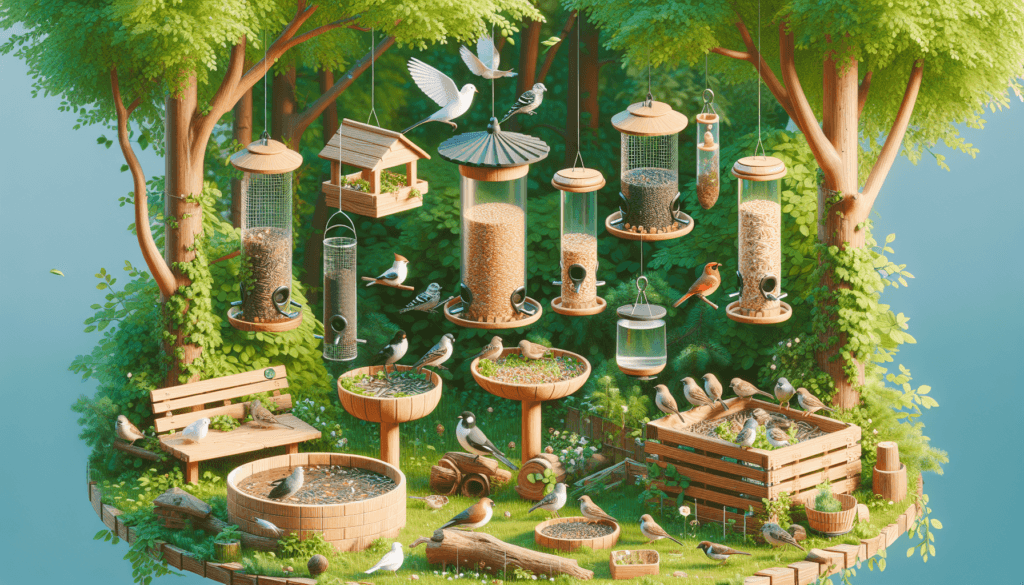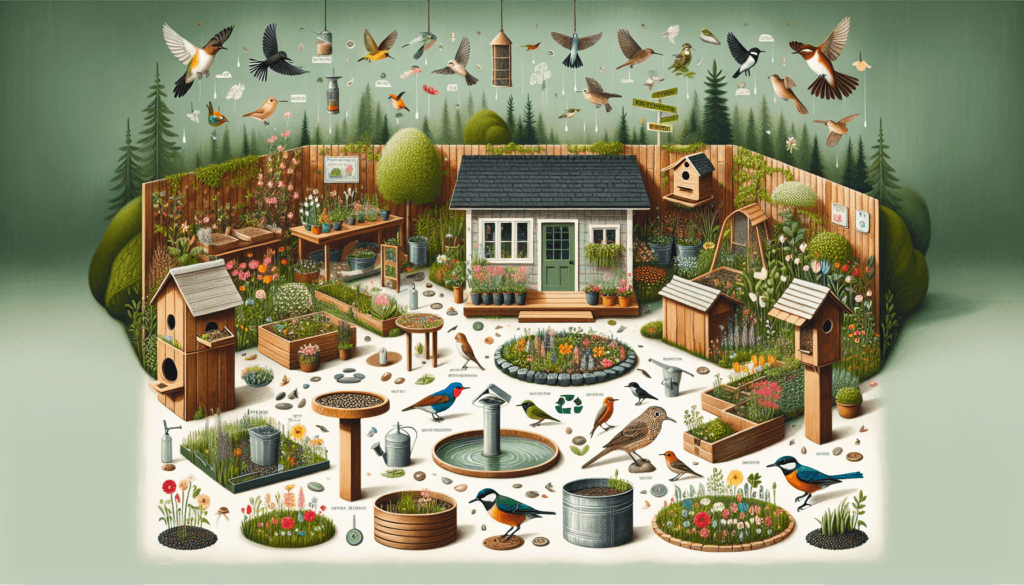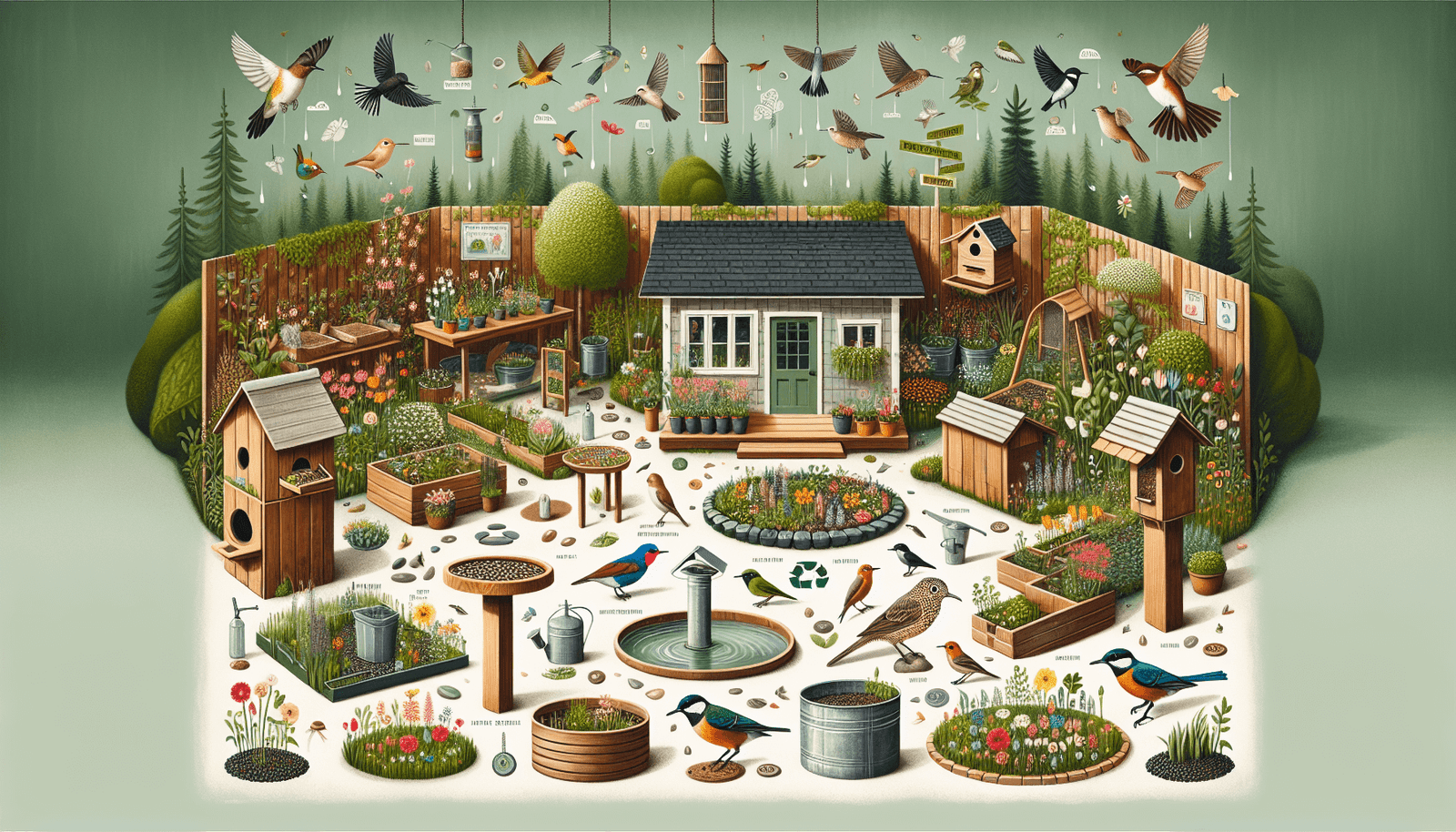Imagine transforming your garden into a vibrant and lively sanctuary for birds, where you can wake up to their melodic tunes every morning. In this article, you will find the top 10 eco-friendly ways to attract birds to your garden. From planting native plants to providing fresh water sources, these tips will not only bring a symphony of feathered friends to your outdoor space but also promote a healthier and more sustainable environment for both you and the birds. So, get ready to create an avian paradise right in your own backyard!

Creating a Bird-Friendly Habitat
Plant Native Trees and Shrubs
One of the best ways to attract birds to your garden is by providing them with a habitat that is familiar and suitable for their needs. Planting native trees and shrubs is an excellent way to create such an environment. Native plants offer food sources in the form of berries, seeds, and nectar, making them a natural attraction for birds. They also provide shelter and nesting sites, as many bird species have evolved to depend on specific plants for their survival. So, do a little research on the native plants in your area and start adding them to your garden. Not only will the birds thank you, but you will also be contributing to the preservation of local ecosystems.
Provide Water Sources
Just like any other living creature, birds need water to survive. By providing them with a reliable water source in your garden, you will not only be attracting birds, but also helping them thrive. You can install birdbaths or even create a small pond or water garden. It’s important to maintain the water source year-round, especially during dry periods when natural water sources may be scarce. Consider adding a dripping or splashing feature to the water source, as birds are attracted to the sound and movement of water. Remember to keep the water source clean and replenish it regularly to prevent the spread of diseases.
Leave Nesting Materials
Offering nesting materials in your garden can greatly encourage birds to make it their home. Birds use various materials such as twigs, leaves, grass, feathers, and moss to build their nests. By leaving a variety of these materials in different areas of your garden, you are giving birds the opportunity to find suitable resources for constructing their nests. Fallen leaves, small branches, and dried grass can all be left undisturbed in certain areas, providing ample materials for nesting. Not only does this help attract birds, but it also contributes to the overall health and shelter of your garden.
Plant Flowers that Attract Insects
Insects are a vital food source for many bird species, especially during the breeding season when they need a steady supply of protein to feed their growing offspring. By planting flowers that attract insects, you are indirectly providing food for the birds. Flowers like sunflowers, coneflowers, and black-eyed Susans are not only visually appealing, but they also attract a wide variety of insects. Choose plants that bloom at different times of the year to ensure a constant supply of insects for the birds. Additionally, avoid using pesticides and chemicals in your garden, as they can harm both the insects and the birds that rely on them for sustenance.
Avoid Pesticides and Chemicals
Speaking of pesticides and chemicals, it’s crucial to avoid using them in your garden if you want to create a truly bird-friendly habitat. Pesticides can be harmful to birds, as they can contaminate their food sources or directly poison them. Even a small amount of pesticide residue on plants or in water can have far-reaching consequences. Instead, opt for natural pest control methods such as companion planting, attracting beneficial insects, or practicing organic gardening. By prioritizing the health and well-being of birds, you are not only creating a safe environment for them but also contributing to a healthier ecosystem as a whole.
Installing Bird Feeders
Choose the Right Feeder
When it comes to bird feeders, it’s essential to choose the right one for the birds you want to attract. Different bird species have different feeding habits, so selecting a feeder that caters to their needs is crucial. Tube feeders with small perches are ideal for attracting small finches and chickadees, while platform feeders are suitable for larger birds like cardinals and jays. Hummingbird feeders should have red flowers to attract these nectar-loving birds. Consider placing different types of feeders in your garden to accommodate a wider range of bird species and provide them with their preferred food sources.
Place Feeders Strategically
Strategic placement of bird feeders can make all the difference in attracting birds to your garden. Birds are more likely to frequent feeders that are located in quiet and safe areas, away from heavy human traffic or potential predators. Ideally, place feeders near natural cover, such as trees or shrubs, where birds can feel protected while feeding. Additionally, consider placing feeders at different heights and in different areas of your garden to accommodate birds with varying feeding preferences. By providing a variety of feeding options, you increase the chances of attracting a diverse array of bird species to your garden.
Use High-Quality Bird Seed
The quality of bird seed you offer can greatly impact the attraction and health of the birds in your garden. Opt for high-quality seed that is free from contaminants, such as mold, dust, or filler ingredients. Different bird species have different dietary preferences, so it’s important to choose a seed mix that appeals to a wide range of birds. Black-oil sunflower seeds are a popular choice, as they are highly nutritious and attract a variety of seed-eating birds. Adding nyjer (thistle) seed can attract finches, while suet can be provided for insect-eating birds like woodpeckers. Providing a balanced and varied diet will ensure that your feathered visitors keep coming back for more.
Clean the Feeders Regularly
Regular cleaning of bird feeders is essential for the health and well-being of the birds. Dirty feeders can harbor bacteria, mold, and other pathogens that can spread diseases among the birds. Clean your feeders at least once every two weeks, or more frequently if necessary, using warm soapy water and a brush. Rinse them thoroughly and allow them to dry completely before refilling. Additionally, remove any spilled seed or debris around the feeders to prevent the buildup of mold or attracting unwanted pests. By maintaining clean and hygienic feeders, you create a safe and inviting environment for birds to enjoy their meals.

Building Nesting Boxes
Research Bird Species and Box Designs
If you want to go a step further in attracting birds to your garden, consider building nesting boxes. Nesting boxes provide birds with additional shelter and safe spaces to raise their young. Before constructing a nesting box, research the bird species that frequent your area and find out their specific requirements for nest boxes. Different bird species have different preferences when it comes to entrance hole size, box dimensions, and placement. Take into account factors such as the bird’s size, nesting habits, and desired habitat to create a suitable nesting box. There are various online resources and guides available to help you design and build the ideal nesting box for the birds you wish to attract.
Position Nesting Boxes Appropriately
Once you have built or purchased a nesting box, it’s crucial to position it appropriately in your garden. Placing the nesting box at the right height and in the right location can greatly increase its chances of being used by birds. Research the specific bird species you are targeting and learn about their habitat preferences and nesting habits. Some birds prefer nesting boxes mounted on trees or poles, while others prefer boxes attached to buildings. Regardless of the type of nesting box, make sure it is placed away from areas with heavy human traffic or excessive noise. Additionally, consider positioning the box in a shaded area to protect it from extreme heat.
Provide Suitable Nesting Materials
Just like with natural nesting sites, birds need suitable materials to construct their nests in the nesting boxes. Provide an assortment of nesting materials in your garden, including twigs, straw, grass, small branches, and feathers. You can place these materials near the nesting boxes or scatter them throughout your garden, allowing birds to collect them as needed. In addition to offering nesting materials, consider planting native plants in your garden that produce soft materials like cottonwood fluff or soft grasses, which birds can use for nesting. By providing a selection of nesting materials, you make it easier for birds to build comfortable and secure nests for their young.
Monitor and Maintain the Boxes
Once you have installed nesting boxes in your garden, it’s essential to monitor them regularly to ensure their functionality and safety. Check the boxes periodically to see if any birds have taken up residence or started nesting. Be mindful of any signs of damage, decay, or predation, and make any necessary repairs or adjustments. Clean out old nests after a nesting season to prevent the spread of diseases or parasites. By staying vigilant and maintaining the nest boxes, you are providing a reliable and safe nesting option for birds in your garden.
Creating Bird-Friendly Landscaping
Avoid Clearing All Fallen Leaves
Leaves that fall from trees and plants in your garden can actually provide valuable resources for birds. Fallen leaves create a natural mulch layer that helps retain moisture in the soil and provides habitat for insects, which are a crucial food source for many bird species. Instead of clearing away all the fallen leaves, consider leaving some in designated areas of your garden. Birds will forage among them, finding insects and other invertebrates to eat. By allowing fallen leaves to remain, you are promoting a healthy ecosystem and providing birds with a natural food source.
Plant Berry-Producing Trees and Shrubs
Adding berry-producing trees and shrubs to your garden is an excellent way to attract birds. Many bird species rely on berries as a food source, especially during the colder months when other food options may be scarce. Certain trees and shrubs, such as holly, elderberry, and serviceberry, produce berries that are highly attractive to birds. Research the native berry-producing plants in your area and select those that are well-suited to your garden’s conditions. By incorporating these plants into your landscaping, you not only provide birds with a reliable food source but also add visual interest and beauty to your garden.
Create Different Levels and Hiding Spots
Birds are naturally drawn to varied landscapes that offer different levels and hiding spots. By creating such an environment in your garden, you will attract a greater diversity of bird species. Use a combination of trees, shrubs, and groundcover plants to create layers of vegetation. Tall trees provide perching and nesting sites, while shrubs offer cover and hiding places. Groundcover plants add an additional layer of habitat and foraging opportunities for birds. By incorporating plants of different heights and densities, you create an engaging and enticing habitat for birds to explore and make their home.
Provide Open Areas for Foraging
While dense vegetation and hiding spots are important, it’s equally important to provide open areas for foraging. Many bird species, such as robins or sparrows, prefer to forage on the ground for insects, seeds, or fallen fruits. Avoid covering your entire garden with thick vegetation, and instead create patches of open bare ground or low-growing plants. This allows birds to easily access their preferred food sources and increases their comfort and safety while foraging. By incorporating open areas into your garden, you cater to the foraging habits of a broader range of bird species, enhancing the overall bird diversity in your backyard.

Providing Shelter and Roosting Sites
Plant Dense Shrubs for Shelter
Shrubs not only add beauty and structure to your garden, but they also serve as valuable shelter for birds. Dense shrubs create a safe haven where birds can take cover from predators, harsh weather conditions, or seek refuge during nesting. Plant a variety of shrubs that offer different densities and heights to accommodate various bird species. Evergreen shrubs provide year-round shelter, while deciduous shrubs offer nesting opportunities and seasonal food sources through their fruits or berries. By planting dense shrubs strategically throughout your garden, you create a network of sheltered areas that birds can rely on for protection and safety.
Install Roosting Poles or Branches
Birds need a secure and comfortable place to rest and roost, especially during the night. Installing roosting poles or branches in your garden can provide birds with elevated perches where they can find rest and shelter. These poles can be as simple as dead tree branches securely planted in the ground or purpose-built structures with multiple branches. Place the poles in quiet areas of your garden, away from any potential disturbances. These man-made roosting sites mimic the natural roosting spots that birds would seek in their native habitats, providing them with a familiar and safe space to rest in your garden.
Provide Brush Piles for Cover
Brush piles are a low-cost and easy way to provide cover and shelter for birds in your garden. They consist of a pile of organic debris such as fallen branches, twigs, and leaves. Birds can hide within the spaces created by the brush pile, protecting themselves from predators or extreme weather conditions. Constructing a brush pile is as simple as stacking the organic materials in a corner of your garden or against a fence. Be sure to place it in a quiet, undisturbed area to avoid causing unnecessary stress to the birds. Brush piles can also provide additional nesting opportunities for certain bird species, further enhancing the attractiveness of your garden.
Avoid Excessive Pruning
While it’s important to maintain the health and structure of your garden, it’s equally important not to prune excessively. Birds rely on trees and shrubs for nesting sites, perching, and shelter. Excessive pruning can remove essential habitat elements, making your garden less appealing to birds. Instead, adopt a more naturalistic approach to pruning, focusing on removing dead or damaged branches rather than shaping plants extensively. Leave a few dead or decaying branches in trees to provide nesting sites for woodpeckers or cavity-nesting birds. By allowing your garden to have a slightly wild and untamed appearance, you create an inviting and suitable habitat for birds.
Attracting Birds with Water Features
Install Birdbaths
Birdbaths are a classic and effective way to attract birds to your garden. They provide birds with a reliable water source for drinking and bathing, especially during hot and dry periods. When installing a birdbath, choose one with a shallow basin that is easily accessible for birds to enter and exit. Place it in a quiet and safe area of your garden, away from potential threats such as cats or other predators. Keep the birdbath filled with clean water, and consider placing a few flat rocks or pebbles in the basin as perching spots for the birds. Regularly clean and replenish the birdbath to prevent the buildup of dirt or algae.
Maintain a Water Source Year-Round
While birdbaths are a great start, consider maintaining a water source in your garden year-round. Birds need water not only for hydration but also for grooming their feathers and regulating their body temperature. Installing a small pond or water garden can provide a more natural and continuous water source for birds. The pond should have a shallow edge to allow easy access for birds to drink and bathe. Add aquatic plants to provide additional cover and perching options. Ensure that the water is kept clean and free of debris, and consider adding a small circulating pump or fountain to keep the water moving and discourage mosquito breeding.
Add a Dripping or Splashing Feature
Birds are naturally attracted to the sights and sounds of moving water. You can enhance the appeal of your water features by adding a dripping or splashing feature. This can be as simple as attaching a drip emitter or a small sprinkler to a nearby water source, allowing water to slowly drip or splash into the birdbath or pond. The sound and movement of the water will catch the attention of birds, attracting them to your garden. This feature has the added benefit of keeping the water fresh and oxygenated, which is beneficial for both the birds and any aquatic life in the water.
Create a Small Pond or Water Garden
If you have the space and resources, consider creating a small pond or water garden in your garden. Ponds provide a larger and more natural water habitat for birds, attracting not only drinking and bathing birds but also those that prefer aquatic environments. With careful planning and consideration, you can design a pond that caters to the needs of various bird species. Include shallow areas, water plants, rocks, and logs for perching and nesting. A well-designed pond not only adds beauty and tranquility to your garden but also serves as a magnet for birds, creating a vibrant and thriving ecosystem right in your backyard.

Using Bird-Friendly Garden Structures
Install Trellises and Arbors
Bird-friendly structures like trellises and arbors serve multiple purposes in your garden. They can provide perching and roosting spots for birds, as well as support climbing plants that attract insects and birds. Choose structures made of natural materials like wood or metal, which blend seamlessly into the garden environment. Opt for designs that are sturdy and secure, as birds may perch or roost on them for extended periods. Consider growing vines or climbing plants on these structures to provide additional habitat and food sources for birds. With the right placement and plant selection, trellises and arbors can become valuable features that attract a wide variety of bird species to your garden.
Hang Birdhouses or Gourd Houses
Birdhouses, also known as nesting boxes, are a tried and tested method of attracting birds to your garden. They provide a safe and suitable alternative for birds to build their nests, especially in areas where natural nesting sites are scarce. Birdhouses come in various sizes and designs, each catering to the specific preferences and needs of different bird species. Hang the birdhouses securely in quiet areas of your garden, away from potential disturbances or predators. Similarly, gourd houses, made from hollowed-out gourds, can also be hung to provide additional nesting opportunities. By offering these bird-friendly structures, you provide birds with nesting options and enhance the bird population in your garden.
Build Bird-Friendly Fences or Walls
Fences and walls can also be utilized to attract birds and provide them with additional habitat options. You can create openings or gaps in your fences or walls to allow birds to move freely into and out of your garden. These openings can vary in size and shape, depending on the bird species you wish to attract. It’s important to ensure that the openings are safe and protected, minimizing the risk of predators gaining access to the garden. Incorporating climbing plants or vines on the fences or walls can add further habitat and food sources for birds. By transforming your fences or walls into bird-friendly structures, you enhance the connectivity and accessibility of your garden to various bird species.
Create Climbing Structures for Vines
Adding climbing plants to your garden not only adds beauty and vertical interest but also provides food sources and habitat for birds. Vines like trumpet vine, clematis, or honeysuckle are known to attract hummingbirds with their nectar-filled flowers. By creating sturdy structures such as trellises, arbors, or pergolas, you provide support for these climbing plants and encourage them to grow. Birds will be naturally attracted to the flowers and foliage of these plants, finding both food and shelter. When choosing climbing plants, opt for native species that are well-suited to your garden’s conditions and that naturally occur in your area. These plants will be more attractive to local bird species, increasing the chances of attracting them to your garden.
Reducing Window Collisions
Apply Decals or Window Films
Window collisions are a significant cause of bird fatalities, as birds often fail to recognize the presence of glass and fly into windows. To reduce the risk of collisions, apply decals or window films to the outside of your windows. These visual markers help birds perceive the presence of the glass and avoid collisions. Decals can come in various designs, ranging from simple shapes to elaborate patterns that mimic spiderwebs or branches. Window films offer a more permanent solution and can also provide additional benefits like privacy and UV protection. By making your windows more visible to birds, you significantly reduce the chances of fatal collisions.
Use External Screens or Netting
Another effective way to prevent bird collisions is by using external screens or netting on your windows. These installations create a physical barrier that prevents birds from flying into the glass. External screens can be made of mesh or wire and are installed a few inches away from the window surface. Netting can be stretched across the window, creating a flexible barrier that also allows air circulation. Ensure that the screens or netting are taut and secure, and regularly check for any damage or gaps. By installing these protective measures, you create a safer environment for birds by eliminating the risk of window collisions.
Move Feeders Away from Windows
To further mitigate the risk of window collisions, consider moving bird feeders away from windows. The movement of birds coming to and from the feeders can often confuse them and result in collisions. By placing feeders at least 30 feet away from windows, birds are less likely to collide with the glass when startled or frightened. Additionally, positioning feeders near natural cover such as trees or shrubs will provide birds with a safe refuge if they become disoriented during their visit to the feeders. By taking these simple steps, you increase the safety and well-being of the birds that frequent your garden.
Create Visual Obstructions
Creating visual obstructions on your windows can also help prevent bird collisions. By applying objects such as window screens, exterior shutters, hanging plants, or wind chimes to the outside of your windows, you break up the reflection and make the presence of the glass more apparent to birds. The key is to place these objects close to the window surface to ensure they are visible from the bird’s perspective. Another option is to draw curtains or close blinds during peak bird activity times, minimizing the reflection and reducing the risk of collisions. By creating visual barriers, you enhance the visibility of windows for birds and greatly reduce their chances of colliding with the glass.

Promoting a Healthy Garden Ecosystem
Practice Organic Gardening
One of the best ways to promote a healthy garden ecosystem is by practicing organic gardening. Avoid using synthetic fertilizers, pesticides, or herbicides that can harm birds directly or indirectly by affecting their food sources. Instead, focus on enhancing the natural health and productivity of your garden through organic methods. Practice composting to enrich the soil, use organic fertilizers like compost or well-rotted manure, and employ natural pest control techniques such as beneficial insects, companion planting, or biological controls. By adopting organic gardening practices, you create a sustainable and harmonious environment that supports the well-being of birds and other wildlife.
Encourage Beneficial Insects
Beneficial insects play a vital role in maintaining a healthy garden ecosystem. Many bird species rely on insects as a food source, especially during the breeding season when they are feeding their young. To attract beneficial insects to your garden, avoid using pesticides and instead create a habitat that meets their needs. Incorporate flowers and plants that attract beneficial insects such as ladybugs, lacewings, or hoverflies. These insects not only provide food for birds but also help control harmful pests in your garden. By creating a favorable environment for beneficial insects, you establish a thriving ecosystem that supports a diverse range of bird species.
Leave Dead Wood and Snags
Dead wood and snags, fallen or standing dead trees, are often overlooked resources in a garden ecosystem. They provide important habitat elements for birds, including nesting sites, perches, and food sources. Many bird species, such as woodpeckers, nuthatches, and chickadees, rely on dead wood for nesting or foraging insects. By leaving dead wood or snags in your garden, you create valuable habitat features that attract these birds and enhance the overall biodiversity. However, be sure to regularly assess the safety of dead trees or branches and remove any that pose a risk of falling or causing damage.
Maintain a Balanced Predator-Prey Ratio
Maintaining a balanced predator-prey ratio is crucial for a healthy garden ecosystem. Predators such as owls, hawks, or snakes play an important role in controlling the population of smaller creatures that can become pests or disrupt the natural balance. Avoid excessive use of rodenticides or other methods that can harm or eliminate the predators in your garden. By allowing natural predator-prey interactions, you prevent the overpopulation of certain species and promote a more stable and sustainable ecosystem. Additionally, providing suitable habitat elements and food sources for the predators will further encourage them to visit and help maintain the balance in your garden.
Observing and Enjoying Birds Safely
Use Binoculars or a Spotting Scope
Observing birds in your garden can be an enjoyable and educational experience. To get a closer look at the birds without disturbing them, use binoculars or a spotting scope. These tools allow you to observe birds from a distance, avoiding any potential stress or disturbance caused by your presence. Binoculars or a spotting scope also enable you to appreciate the finer details of bird behavior, plumage, and movement. Remember to always use these tools responsibly and be mindful of the birds’ well-being by keeping a respectful distance.
Keep Distance and Avoid Disturbances
When enjoying birds in your garden, it’s important to keep a reasonable distance and avoid disturbances that may cause stress or disrupt their behavior. Birds need a sense of security to carry out their daily activities, such as feeding, mating, or nesting. Approach quietly and move slowly to minimize any sudden movements that may startle the birds. Avoid getting too close or crowding around them, as this can cause unnecessary stress. By keeping a respectful distance and allowing birds to carry on with their natural behaviors undisturbed, you can observe their beauty and behavior while minimizing any negative impact on their well-being.
Offer Shelter from Extreme Weather
Extreme weather conditions can have a significant impact on the health and survival of birds. During extreme heat or cold, birds may struggle to regulate their body temperature or find suitable shelter. You can help by offering temporary shelter options in your garden. Place birdhouses or nesting boxes in areas that provide shade or protection from the elements. Consider planting dense shrubs or trees that birds can seek for cover during extreme weather events. Additionally, providing supplemental food during periods of heavy snow or extended drought can greatly assist birds in overcoming challenging weather conditions. By offering shelter and support, you contribute to the well-being and resilience of the birds in your garden.
Learn to Identify Different Bird Species
A fundamental aspect of birdwatching is being able to identify different bird species. Learning to recognize and distinguish between various birds enhances your overall experience and understanding of the avian world. Invest time in studying bird field guides, books, or online resources to familiarize yourself with different species. Pay attention to their physical characteristics, behaviors, and preferred habitats. Take note of the unique songs or calls of each species, as this can be a helpful identification tool. Participating in local birdwatching groups or guided tours can also provide opportunities to learn from experienced birdwatchers. By expanding your knowledge and skills, you can better appreciate and contribute to the conservation of bird species in your garden and beyond.
In conclusion, creating a bird-friendly habitat in your garden is not only a rewarding and enjoyable endeavor, but it also contributes to the overall health and well-being of bird species. By following the eco-friendly ways outlined above, you can attract a diverse array of birds to your garden, support their nesting and foraging needs, and contribute to the preservation of bird populations. From planting native trees and shrubs to providing water sources and creating suitable nesting materials, each step plays a vital role in creating a thriving and harmonious environment for birds. So, dive into the world of bird-friendly gardening and get ready to welcome a symphony of birdsong and vibrant avian visitors to your garden.


